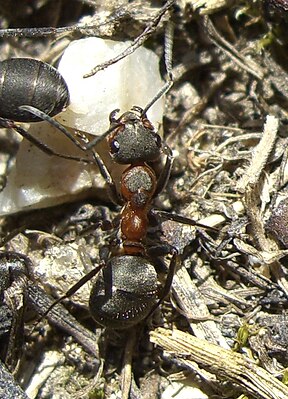Large meadow ant
| Large meadow ant | ||||||||||
|---|---|---|---|---|---|---|---|---|---|---|

Great meadow ant ( Formica pratensis ) |
||||||||||
| Systematics | ||||||||||
|
||||||||||
| Scientific name | ||||||||||
| Formica pratensis | ||||||||||
| Retzius , 1783 |
The great meadow ant ( Formica pratensis ) belongs to the genus of wood ants ( Formica ) in the subfamily of scale ants (Formicinae).
features
The front part of the body is predominantly colored red, the gaster and top of the head are black. The two large spots on the pronotum and mesonotum are just as deep black and mostly clearly delineated. The legs , the antennae and the well-defined mouthparts are black-brown. The top of the body is almost entirely covered with short bristles, which makes the surface appear more matt and coarser than other species of wood ants. The workers are 4.5 to 9.5 millimeters long and are therefore slightly larger on average than the representatives of other species such as the red wood ant ( Formica rufa ) or the bald-backed wood ant ( Formica polyctena ). The sex animals are 9 to 11 millimeters long.
distribution and habitat
Their distribution area stretches in the Palearctic from the Pyrenees to the Yenisei in Siberia . In Europe it occurs from Fennoscandia (63.5 ° North) to the Balkans (41 ° North). In the Alps it settles up to an altitude of 1,500 meters. It prefers well-sunlit areas in open areas such as bushy dry grass , dry heather and meadow slopes near groups of trees. It can be found on roadsides and embankments.
Way of life
The great meadow ant usually forms monogynous or weakly polygynous states. Often the state lives in a single nest, polydome nest colonies rarely develop, actually only in the absence of dominant species (e.g. red wood ant ( F. rufa )). The initial establishment of a colony is socially parasitic in slave ants ( Serviformica ), mostly in the red-backed slave ant ( F. cunicularia ).
As a specialty, this forest ant species forms a second brood of sex animals every year. The first generation raves between late April and mid-July, the second generation between mid-August and late September. This second generation of sex animals, as well as the size of the workers, is made possible by the increased feeding with glandular secretions, since all workers of the great meadow ant have exceptionally well-developed food glands.
The diet consists mainly of insects and other small prey, as well as from honeydew of aphids . It contributes to the spread of myrmekochoren plants whose oily seed appendages ( elaiosomes ) are used as food. The scattered dome of their hill nests consists of bitten stalks, tree needles and small branches. The diameter can be over a meter, but the hills are always very flat.
Hazard and protection
The large meadow ants and their nests, like all hill-building forest ants in Germany, are specially protected under the Federal Species Protection Ordinance. According to the Red List of Germany, they are considered to be severely endangered (Category 2).
Systematics
The great meadow ant ( Formica pratensis ) is divided into the following subspecies:
- F. pratensis pratensis Retzius, 1783
- F. pratensis starkei Betrem, 1960
A very similar species is Formica nigropratensis Betrem 1962. Another meadow ant, Formica nigricans Emery 1909, was classified by Bernhard Seifert in 1996 as an ecomorphic form of Formica pratensis .
Individual evidence
- ↑ Dieter Otto: The red wood ants . 3. Edition. Westarp Sciences, Hohenwarsleben 2005, ISBN 3-89432718-9 ( The new Brehm library. Volume 293)
- ↑ a b Bernhard Seifert : The ants of Central and Northern Europe . lutra Verlags- und Vertriebsgesellschaft, Görlitz / Tauer 2007, ISBN 978-3-936412-03-1
- ^ Formica pratensis pratensis. Fauna Europaea, accessed May 25, 2007 .
- ^ Formica pratensis starkei. Fauna Europaea, accessed May 25, 2007 .
Web links
- Pictures of Formica pratensis at the German Ant Conservation Center
- Formica pratensis inthe IUCN 2013 Red List of Threatened Species . Listed by: Social Insects Specialist Group, 1996. Retrieved October 9, 2013.
